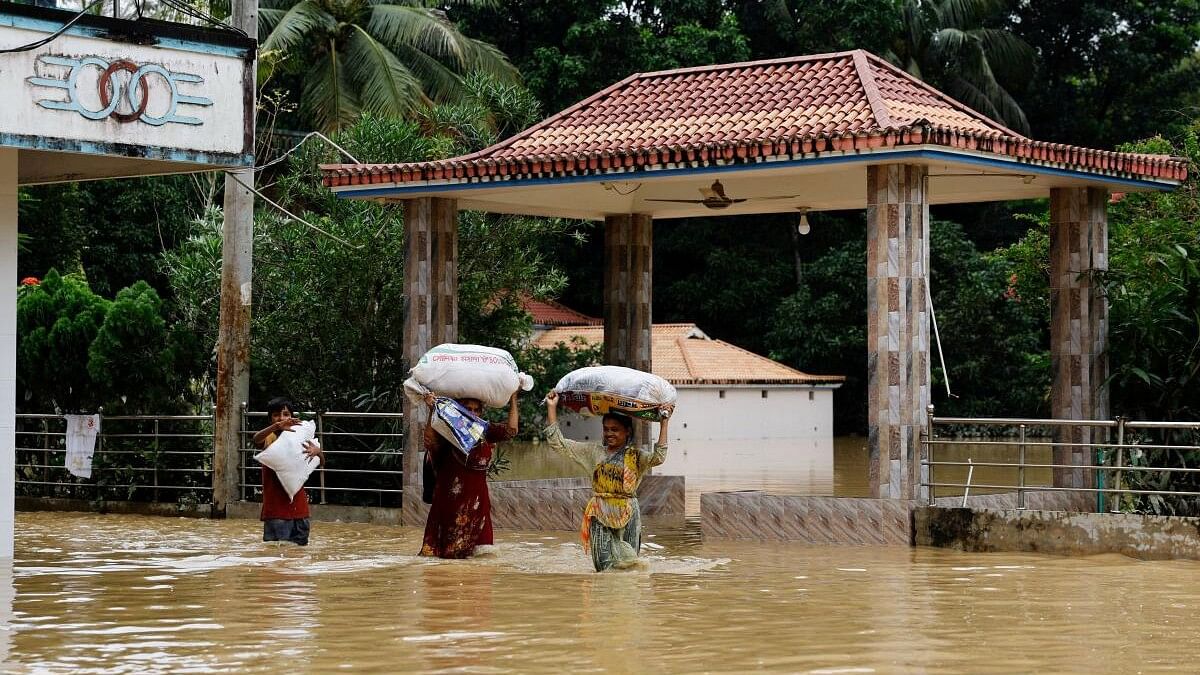
People carrying sacks, wade through flood water, amid severe flooding in the Fazilpur area of Feni, Bangladesh.
Credit: Reuters photo
Dhaka: At least 59 people, including six women and 12 children, have died in the devastating floods which affected more than five million people in 11 districts of Bangladesh, officials announced on Saturday.
The Disaster Management and Relief Ministry, while giving out updates on the flood situation, said the highest deaths were reported from Cumilla and Feni districts, both adjoining the border with Tripura in India on the northeast side, with 14 and 23 deaths respectively.
Monsoon rainfall-triggered floods in deltaic Bangladesh and upstream Indian regions have wreaked havoc in the country for about two weeks resulting in deaths and displacement of humans and cattle, and loss of property posing a huge administrative challenge to the newly installed interim government amid a political transition.
Bangladesh is crisscrossed by more than 200 rivers, 54 of them being trans-boundary rivers with upper riparian India, in four major basins. A depression (a system that brings in copious rainfall) in the Bay of Bengal last week had led to the current deluge with rivers in two basins – the north-eastern Meghna Basin and south-western Chattrogram Hills Basin – witnessing widespread flooding.
“As many as 54,57,702 people have been affected by the flood in 504 unions and municipalities across the 11 districts. About 0.7 million families remained stranded in the flood currently while nearly 0.4 million people are staying at 3,928 shelter centres,” state-run news agency, the Bangladesh Sangbad Sangtha (BSS), said quoting the Disaster Management and Relief Ministry officials.
A total of 36,139 cattle were also given shelter there, it said adding, as the situation improves by the day, people are returning home even as communication systems have become normal in flood-affected districts.
Weather experts had said that apart from the torrential rains, the overflowing rivers, El Nino and climate change phenomenon were the factors responsible for widespread flooding in the country.
Earlier last week, the Flood Warning and Forecasting Centre (FFWC) had come under criticism for failure to predict the situation even as the officials attributed the situation to a lack of information from counterparts in the upstream Indian region.
The situation had become bizarre as local government representatives were unavailable or on the run because of their political affiliation after the ouster of former prime minister Sheikh Hasina’s Awami League regime in a student-people upsurge earlier in the month. That made it difficult for relief coordination, local media reports had said.
The floods had hit the country as interim government’s Chief Adviser Muhammad Yunus was overhauling the bureaucracy by changing their heads.
The new government has also sacked more than 1,800 elected local government representatives across the country since Yunus, 84, assumed charge on August 8 three days after Hasina, 76, stepped down on August 5 and fled to India amidst a mass uprising that followed attacks, vandalism and killings of many people loyal to her.